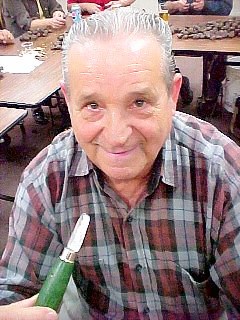For four decades starting in the 1950s, Dominico Pirillo used this knife to cut shoe leather at Empire Shoe Repair.
This weekend, Pirillo was wielding the blade for a different purpose -- the high art of Calabrese chestnut-knicking.
The Sault's Calabrese Society tonight hosted its 14th Annual Chestnut Feste and Dinner Dance, at which a 12-course banquet was culminated by steaming mounds of fresh-roasted chestnuts.
SooToday News spent the previous evening in the basement of the Marconi Club, apprenticing at the feet of Pirillo and other master chestnut-knickers.
As these consummate craftsmen (and ladies) prepared nine 55-pound sacks of nuts for roasting, we prevailed on them to reveal the secrets of the castagne.
SooToday photo essay
Click on the following links to meet some of the Sault's master chestnut-knickers:
Tony Guzzo cuts across the grain Mary Pirillo shows us how to carry a 55-pound bag of chestnuts Tony Zagardo uses an electrician's knife Rosina Zagardo with a store-bought chestnut knicker Frank Musso prefers a utility knife to avoid blisters Angelo Fera started the popular Chestnut Feste in 1989 Club Calabrese's champion chestnut-knicking team
Northern Italians turn up noses at the lowly nut
Chestnuts have been used for food since ancient times.
Guido Caputo, president of Club Calabrese, tells us that the sweet, non-oily nuts are an integral part of the local diet in Calabria, the region of Southern Italy from which most of the Sault's Italian Canadians trace their lineage.
"Ironically, the northern inhabitants shun such a bourgeois diet and feed them to their animals," Caputo says.
It's important he tell us this, because so far, SooToday News employs only wannabe Italians ignorant of the culture and unable to speak a single word of the language.
That needs to change. But in the meantime, we're learning from Mary Pirillo, who's sharing how chestnuts fit into her diet when she was growing up in the town of Fighine in Cosenza Province.
Chestnuts for breakfast
"My grandfather used to get up early in the morning and make us chestnuts for breakfast," Pirillo recalls. "We ate them with bread sticks."
"You can get chestnut bread and jam," Pirillo says.
At tonight's function at the Marconi, the menu includes chestnut ice cream.
How the Calabrese get their knicks
The first thing to know about chestnuts, we're told, is that they must be 'knicked' before roasting.
This is to prevent them from exploding.
Not wishing to experience exploding nuts, SooToday anxiously sets out to learn the proper technique.
And we soon learn that among the Sault Calabrese, there's more than one way to knick a nut.
In fact, there are so many techniques and tools that we suspect this is the sort of thing that wars were fought over back in the days of the European city-states.
Knickers in a knot
Frank Musso shows off his large-handled utility knife, which he insists is the best tool for slicing through the hard external skin and into the flesh of the nut.
Last year, Musso went home with a blistered hand after an evening of chestnut-knicking. This year, he has to play accordion and keyboard on Saturday night and he's intent on saving his hands.
The utility knife is working just fine, he says.
Down the table, Rosina Zagardo has a fancy plastic knicking tool that her sister found in a shop.
Top or bottom?
Her husband Tony finds that a curved electrician's knife works best to knick the curved top of the walnut.
But others maintain that's just not the way it's done.
You're supposed to knick the flat bottom of the chestnut, not the round top, insists Tony Guzzo.
That way, Guzzo tells us, it's easier to remove the skin after the nut is roasted, with none of the bitter membrane attached.
Along or against the grain?
Then, the discussion shifts to whether the knick is best cut along or against the grain, and whether the best cut is v-shaped or straight.
Tony Zagardo isn't buying any of this.
"It makes no difference how you cut," he declares.
As the Great Calabrese Chestnut-Knicking debate continues, it turns out even deeper issues are at play.
Oven-roasted or microwave?
Zagardo, we learn, likes to cut the tops because he lays his chestnuts on their flat bottoms to cook them in the microwave.
This draws guffaws from some fellow knickers who maintain the only way to cook chestnuts is to oven-roast them.
Now, it's time for Frank Carluelli to weigh in.
The die-hard purist
According to Carluelli, the only way to roast a chestnut is in an old frying pan over a wood fire.
For purists like him, there even has to be a hole in the bottom of the frying pan to ensure even distribution of flame.
Microwaved chestnuts?
"Ka-ka," Carluelli chides us, with a wink.
Okay. We understood that.
So maybe SooToday does know at least one word in Italian.
Celebrating our community
SooToday.com is completely independent from the Sault Star, Sault This Week and all other news media. We're Sault-owned and an overwhelming majority of our thousands of readers consider us their favourite source for local news. If you appreciate our innovative, upbeat approach to community journalism, why not make us your home page? Just click here.
